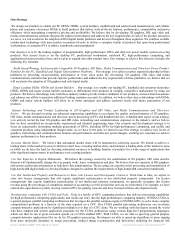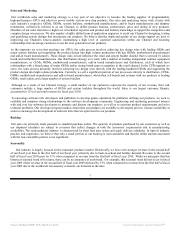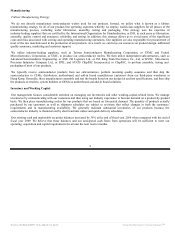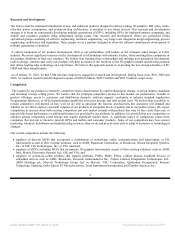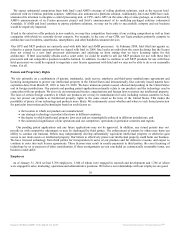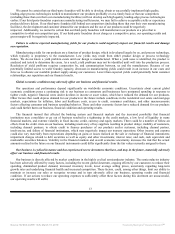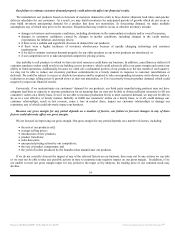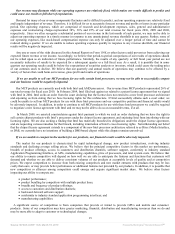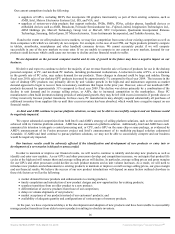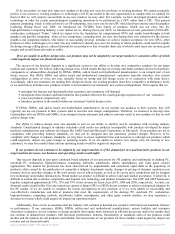NVIDIA 2010 Annual Report Download - page 21
Download and view the complete annual report
Please find page 21 of the 2010 NVIDIA annual report below. You can navigate through the pages in the report by either clicking on the pages listed below, or by using the keyword search tool below to find specific information within the annual report.
We cannot be certain that our third-party foundries will be able to develop, obtain or successfully implement high quality,
leading-edge process technologies needed to manufacturer our products profitably or on a timely basis or that our competitors
(including those that own their own manufacturing facilities) will not develop such high quality, leading-edge process technologies
earlier. If our third party-foundries experience manufacturing inefficiencies, we may fail to achieve acceptable yields or experience
product delivery delays. If our third-party foundries fall behind our competitors (including those that own their own manufacturing
facilities), the development and customer demand for our products and the use of our products could be negatively
impacted. Additionally, we cannot be certain that our third-party foundries will manufacturer our products at a price that is
competitive to what our competitors pay. If our third-party foundries do not charge us a competitive price, our operating results and
gross margin will be negatively impacted.
Failure to achieve expected manufacturing yields for our products could negatively impact our financial results and damage
our reputation.
Manufacturing yields for our products are a function of product design, which is developed largely by us, and process technology,
which typically is proprietary to the manufacturer. Low yields may result from either product design or process technology
failure. We do not know a yield problem exists until our design is manufactured. When a yield issue is identified, the product is
analyzed and tested to determine the cause. As a result, yield problems may not be identified until well into the production process.
Resolution of yield problems requires cooperation by, and communication between, us and the manufacturer. Because of our
potentially limited access to wafer foundry capacity, decreases in manufacturing yields could result in an increase in our costs and
force us to allocate our available product supply among our customers. Lower than expected yields could potentially harm customer
relationships, our reputation and our financial results.
Global economic conditions may adversely affect our business and financial results.
Our operations and performance depend significantly on worldwide economic conditions. Uncertainty about current global
economic conditions poses a continuing risk to our business as consumers and businesses have postponed spending in response to
tighter credit, negative financial news and/or declines in income or asset values, which have reduced the demand for our products.
Other factors that could depress demand for our products in the future include conditions in the residential real estate and mortgage
markets, expectations for inflation, labor and healthcare costs, access to credit, consumer confidence, and other macroeconomic
factors affecting consumer and business spending behavior. These and other economic factors have reduced demand for our products
and could further harm our business, financial condition and operating results.
The financial turmoil that affected the banking system and financial markets and the increased possibility that financial
institutions may consolidate or go out of business resulted in a tightening in the credit markets, a low level of liquidity in many
financial markets, and extreme volatility in fixed income, credit, currency and equity markets. There could be a number of follow-on
effects from the credit crisis on our business, including insolvency of key suppliers resulting in product delays; inability of customers,
including channel partners, to obtain credit to finance purchases of our products and/or customer, including channel partner,
insolvencies; and failure of financial institutions, which may negatively impact our treasury operations. Other income and expense
could also vary materially from expectations depending on gains or losses realized on the sale or exchange of financial instruments;
impairment charges related to debt securities as well as equity and other investments; interest rates; and cash, cash equivalent and
marketable securities balances. Volatility in the financial markets and overall economic uncertainty increases the risk that the actual
amounts realized in the future on our financial instruments could differ significantly from the fair values currently assigned to them.
Our business is cyclical in nature and has experienced severe downturns that have, and may in the future, materially adversely
affect our business and financial results.
Our business is directly affected by market conditions in the highly cyclical semiconductor industry. The semiconductor industry
has been adversely affected by many factors, including the recent global downturn, ongoing efforts by our customers to reduce their
spending, diminished product demand, increased inventory levels, lower average selling prices, uncertainty regarding long-term
growth rates and underlying financial health and increased competition. These factors, could, among other things, limit our ability to
maintain or increase our sales or recognize revenue and in turn adversely affect our business, operating results and financial
condition. If our actions to reduce our operating expenses to sufficiently offset these factors during this downturn are unsuccessful,
our operating results will suffer.
13
Source: NVIDIA CORP, 10-K, March 18, 2010 Powered by Morningstar® Document Research℠


